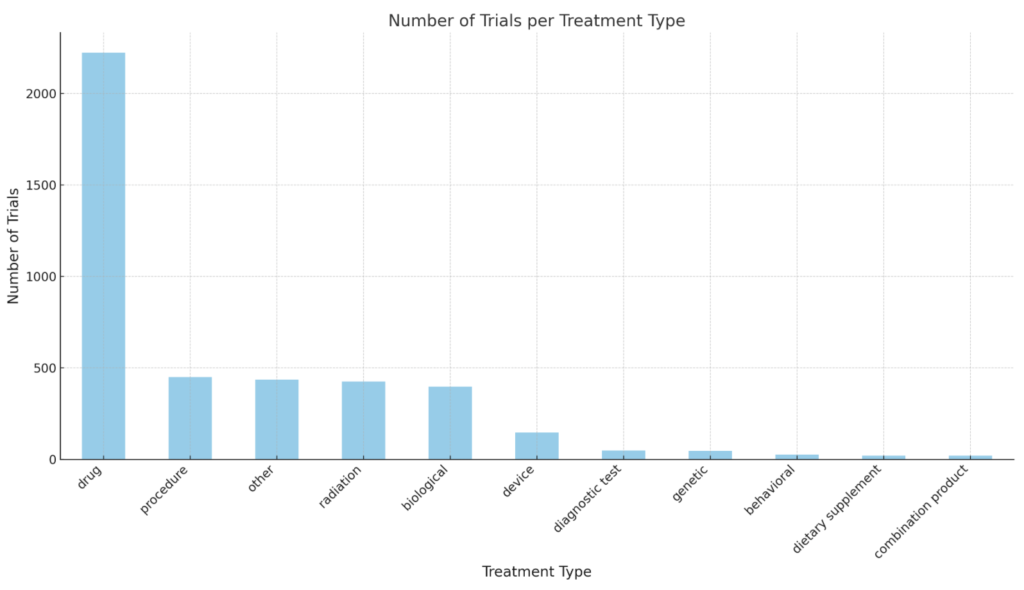Glioblastoma Treatments in Deep
I hope you have found interesting the previous article where we analyse the content of the clinical trials database. In this case you will find even more interesting this one where we decided to analyse the most studied treatments. The purpose is to reduce the knowledge gap between the specialists and the patients and caregivers in order to increase trust and facilitate and informed selection of the best treatment options. Here is a chart illustrating the different categories of treatments and their cardinality, meaning the number of trials associated with each treatment type. As seen, ‘Drug’ treatments have the highest number of trials, followed by ‘Radiation’, ‘Other’, and so on.

Here are some insights and details based on the chart:
- Drug Treatments: This category leads by a significant margin, indicating that pharmacological interventions are the most researched approach for glioblastoma treatment. This is common in oncology, where drug therapy, especially chemotherapy, targeted therapy, and immunotherapy, plays a central role. The high number of trials in this category reflects the ongoing search for more effective and tolerable drug combinations and new compounds.
- Radiation: This is the second most common treatment type, which aligns with the standard care for glioblastoma involving radiation therapy, often in combination with chemotherapy (notably, Temozolomide). The significant number of trials in this category suggests ongoing research to optimize radiation techniques, dosages, and combinations with other treatments to improve outcomes and reduce side effects.
- Other: This category includes various interventions that do not fit neatly into the other predefined categories. This could encompass supportive care measures, lifestyle interventions, or unique non-standard therapies. The diversity within this category highlights the complexity of glioblastoma treatment and the need for holistic approaches alongside direct cancer treatments.
- Procedure and Biological: Procedures may include surgical techniques, while biological treatments involve using living organisms, substances derived from living organisms, or laboratory-produced versions of such substances to treat disease. The presence of these categories underscores the multifaceted approach to glioblastoma treatment, which can include surgery to remove tumor mass and biological therapies like vaccines or cell therapies aimed at harnessing the body’s immune system.
- Device, Genetic, Dietary Supplement, Diagnostic Test, Combination Product, Behavioral: These categories represent less common but emerging areas of research. Devices may include things like implantable drug delivery systems or new imaging technologies. Genetic treatments reflect the growing interest in personalized medicine based on genetic profiling. Dietary supplements and behavioral interventions explore supportive care and lifestyle factors that might affect prognosis or quality of life. Diagnostic tests are crucial for early detection, monitoring, and treatment planning. Combination products could indicate trials testing integrated therapies combining drugs, devices, or biological agents.
Overall, the diversity in treatment types being studied highlights the complex nature of glioblastoma and the multifaceted approach required to treat it. The emphasis on drug and radiation therapy aligns with current standard treatments, but the wide range of other treatments being investigated suggests that researchers are exploring every possible angle to improve patient outcomes, reduce side effects, and enhance quality of life. The research landscape depicted by these trials is one of innovation and exploration, aiming to tackle glioblastoma from multiple fronts. I may be interesting to analyse for each category which is the most studied based on the number of clinical trials:
- Drug: Temozolomide, with 322 trials. This aligns with the current standard of care for Glioblastoma, highlighting its central role in treatment regimens.
- Radiation: Radiation therapy, with 129 trials. This underscores its importance as a conventional treatment option for Glioblastoma, often used alongside surgery and chemotherapy.
- Other: Laboratory biomarker analysis, with 109 trials. This indicates a significant focus on personalized medicine and the identification of biomarkers that can predict treatment response or disease progression.
- Procedure: Conventional surgery, with 39 trials. Surgery is a primary treatment for Glioblastoma to remove as much of the tumor as possible, reflected in the number of studies.
- Biological: Bevacizumab, with 28 trials. While classified here under biological due to its nature as a monoclonal antibody, it also functions as a drug, emphasizing the interest in targeted therapies.
- Device: Optune, with 7 trials. This represents the interest in novel treatment modalities such as Tumor Treating Fields (TTF).
- Genetic: Gene expression analysis, with 6 trials. This suggests an interest in understanding the genetic underpinnings of Glioblastoma, which can lead to more targeted and personalized treatments.
- Dietary Supplement: Ascorbic acid, with 2 trials. While less common, this indicates exploration into how supplements might affect cancer or treatment side effects.
- Diagnostic Test: Blood sample, with 2 trials. This reflects the ongoing search for minimally invasive diagnostic tools that could offer earlier detection or monitor treatment response.
- Combination Product: Temozolomide (also appearing in the drug category), with 2 trials, suggests exploring the combination of standard drugs with other treatment modalities.
- Behavioral: Palliative care, with 1 trial. This is essential in improving the quality of life for patients dealing with severe illnesses like Glioblastoma.
These results highlight the diversity of research within Glioblastoma treatments, from standard therapies like drugs and surgery to innovative approaches like genetic analysis and medical devices. The predominance of Temozolomide across different categories underlines its central role in Glioblastoma therapy. The variety and depth of investigation across categories reflect the complexity of treating this aggressive cancer and the medical community’s efforts to improve outcomes through various avenues of research.
Please – do you know where the FDA is in the approval process for DC-Vax?
Thank you!
In UK and US but unfortunately I don’t have more precise info.
Is Sonodynamic (focused ultrasound) therapy considered DEVICE?